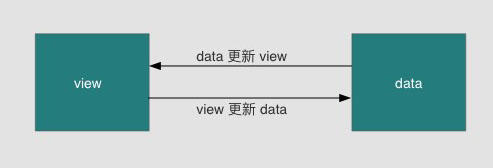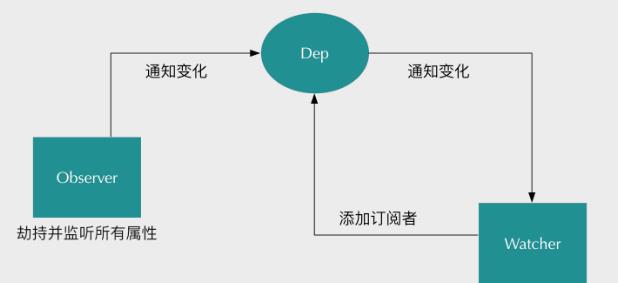Vue数据绑定原理及简单实现
Posted
tags:
篇首语:本文由小常识网(cha138.com)小编为大家整理,主要介绍了Vue数据绑定原理及简单实现相关的知识,希望对你有一定的参考价值。
本篇文章中的代码只是部分片段,完整代码存放于github上https://github.com/Q-Zhan/simple-vue。
进入正文~实现数据绑定主要是要实现两个方面的功能:数据变化导致视图变化,视图变化导致数据变化。后者比较容易实现,就是监听视图的事件,然后在回调函数中改变数据。所以重点是数据变化时如何改变视图。
这里的思路是通过object.defineProperty()来对数据的属性设置一个set函数,设置后当数据改变时set函数就会被调用,我们就可以里面进行视图更新操作。

具体实现过程

如上图所示,我们需要一个监听器Observer来给所有的属性设置set函数。如果属性发生了变化,就要通知所有的订阅者Watcher。而这些Watcher统一存放在消息订阅器Dep中,这样比较方便统一管理。Watcher接受到来自Dep的通知后就执行相应的操作去更新视图。
Observer
监听器的核心代码如下:
function observe(data) {
if (!data || typeof data !== ‘object‘) {
return;
}
Object.keys(data).forEach(function(key) { // 遍历属性,递归设置set函数
defineReactive(data, key, data[key]);
});
}
function defineReactive(data, key, val) {
observe(val)
var dep = new Dep()
Object.defineProperty(data, key, {
enumerable: true,
configurable: true,
get: function() {
if (Dep.target) {
dep.addSub(Dep.target) // 添加watcher
}
return val
},
set: function(newVal) {
if (val === newVal) {
return;
}
val = newVal;
dep.notify() // 通知dep
}
})
}通过调用observe()函数来递归地给data对象设置set和get函数,在data的属性被get时添加watcher,被set时通知dep,dep的notify会接着通知所有的watcher去执行更新操作。
Dep
消息订阅器的核心代码如下:
function Dep() {
this.subs = [] // 订阅者数组
}
Dep.prototype = {
addSub: function(sub) {
this.subs.push(sub)
},
notify: function() {
this.subs.forEach(function(sub) {
sub.update()
})
}
}
Dep.target = null消息订阅器比较简单,就是维护一个subs数组。当监听新属性时把它push进subs数组中,然后dep被通知时触发notify函数,从而触发subs数组中每个watcher的update操作。
Watcher
function Watcher(vm, exp, cb) {
this.cb = cb
this.vm = vm
this.exp = exp
this.value = this.get()
}
Watcher.prototype = {
update: function() {
this.run()
},
run: function() {
var value = this.vm.data[this.exp]
var oldVal = this.value
if (value !== oldVal) {
this.value = value
this.cb.call(this.vm, value, oldVal) // 执行更新时的回调函数
}
},
get: function() {
Dep.target = this
var value = this.vm.data[this.exp] // 读取data的属性,从而执行属性的get函数
Dep.target = null
return value
}
}Watcher的主要功能是去触发属性的get函数,从而添加watcher到Dep的subs数组中。另外就是在update()中更新属性的值并触发更新回调函数。
使用Watcher的方法如下:
var el = document.getElementById(‘XXX‘)
observe(data)
new Watcher(vm, exp, function(value) { // vm表示某个实例,exp表示属性名
el.innerhtml = value
})为了使用时的整洁,我们需要把代码稍微包装下。
SimpleVue
function SimpleVue (data, el, exp) {
var self = this
this.data = data
Object.keys(data).forEach(function(key) {
self.proxyKeys(key)
})
observe(data)
el.innerHTML = this.data[exp]
new Watcher(this, exp, function(value) {
el.innerHTML = value
})
return this
}
SimpleVue.prototype = {
proxyKeys: function(key) {
var self = this
Object.defineProperty(this, key, {
enumerable: false,
configurable: true,
get: function() {
return self.data[key]
},
set: function(newVal) {
self.data[key] = newVal
}
})
}
}使用如下:
// html
<h1 id="name">{{name}}</h1> //这个{{name}}暂时没用
// js
var el = document.querySelector(‘#name‘)
var selfVue = new SimpleVue({ name: ‘hello‘}, el, ‘name‘)
setTimeout(function() {
selfVue.name = ‘123‘
}, 2000)需要注意的是SimpleVue原型的proxyKeys是为了将selfVue.data.name这种操作代理为selfVue.name。这下我们就可以直接通过selfVue.name = "XXX"来改变数据了,并且视图也会相应变化。
Compile
上面的例子都是写死一个属性去替换,而真正的使用时我们需要去解析dom节点,对类如{{}}的进行替换并绑定watcher。这个解析过程通过Compile来实现。
nodeToFragement: function(el) {
var fragment = document.createDocumentFragment()
var child = el.firstChild
// 将dom节点移到fragment
while(child) {
fragment.appendChild(child)
child = el.firstChild
}
return fragment
},
compileElement: function(el) {
var childNodes = el.childNodes
var self = this;
[].slice.call(childNodes).forEach(function(node) {
var reg = /\\{\\{(.*)\\}\\}/
var text = node.textContent
if (self.isTextNode(node) && reg.test(text)) {
self.compileText(node, reg.exec(text)[1])
}
if (node.childNodes && node.childNodes.length) {
self.compileElement(node) // 递归遍历子节点
}
});
},
compileText: function(node, exp) {
var self = this
var initText = this.vm[exp]
this.updateText(node, initText)
new Watcher(this.vm, exp, function(value) {
self.updateText(node, value)
})
},compile主要做三件事情。一是将dom节点移入DocumentFragment中去,因为DocumentFragment中操作dom节点不会引起浏览器的重绘,性能会比直接操作dom节点好很多。二是递归调用compileElement函数来遍历所有子节点,如果子节点包含{{}}形式的则调用compileText。三是compileText函数创建新的watcher。
当然加入compile后SimpleVue也要有相应的变化:
function SimpleVue (options) {
var self = this
this.vm = this
this.data = options.data
Object.keys(this.data).forEach(function(key) {
self.proxyKeys(key)
})
observe(this.data)
new Compile(options.el, this.vm)
return this
}以上是关于Vue数据绑定原理及简单实现的主要内容,如果未能解决你的问题,请参考以下文章